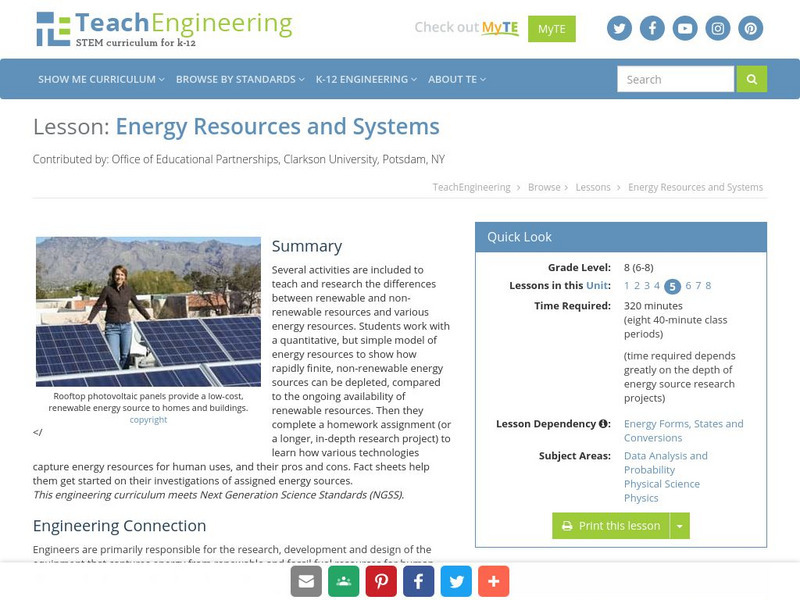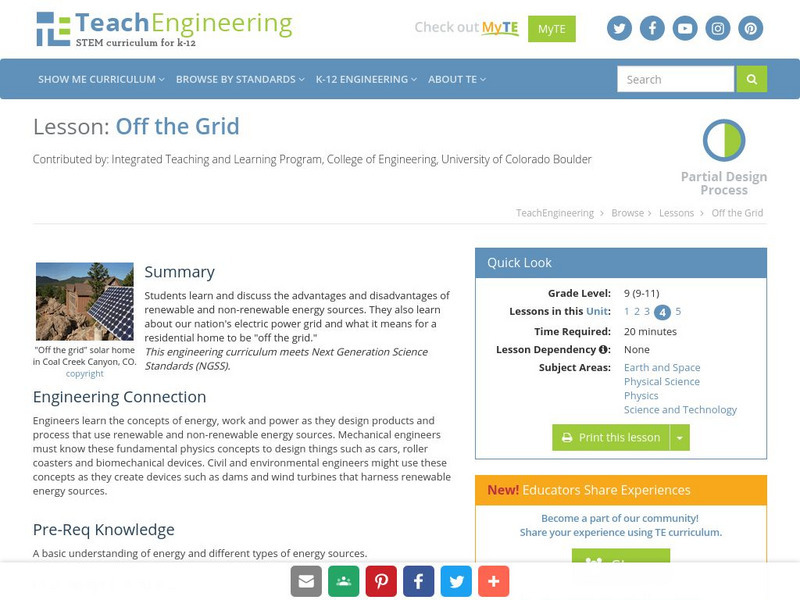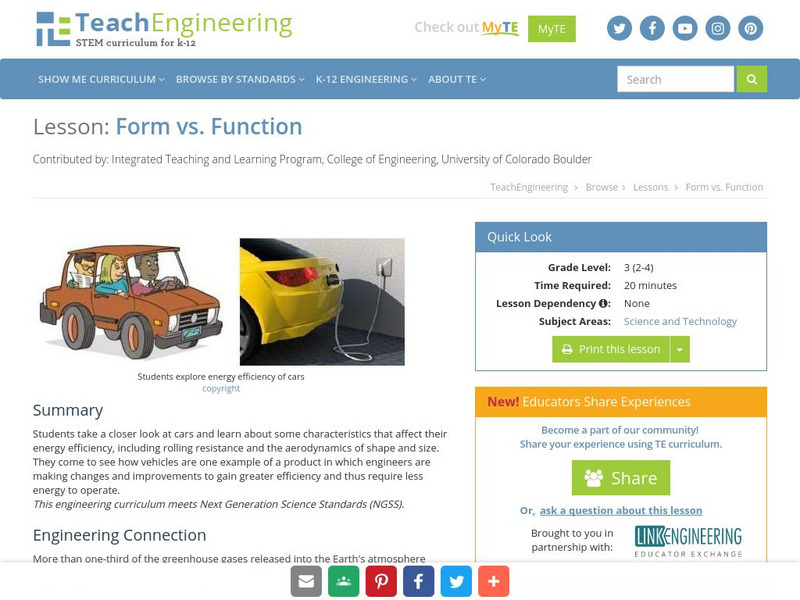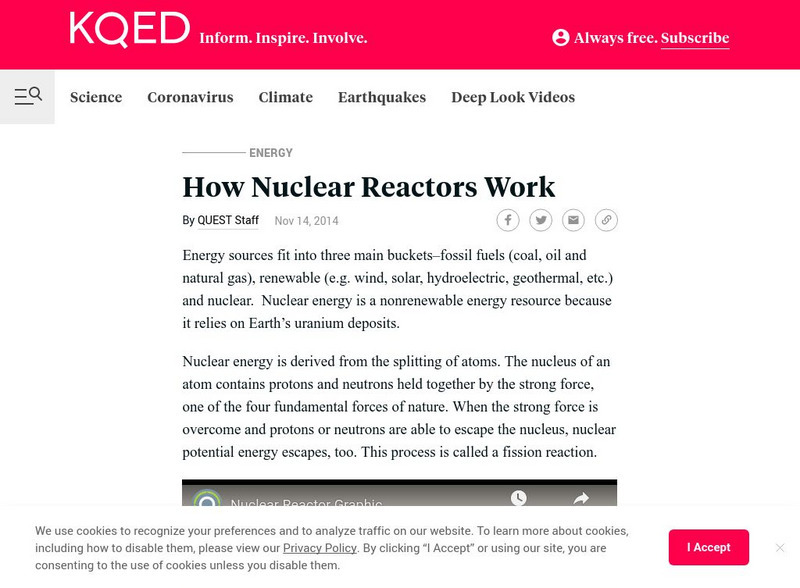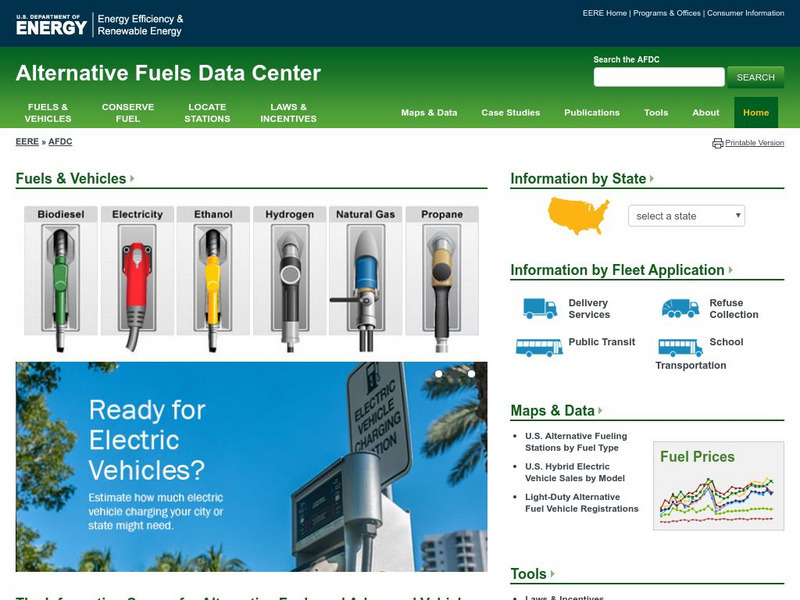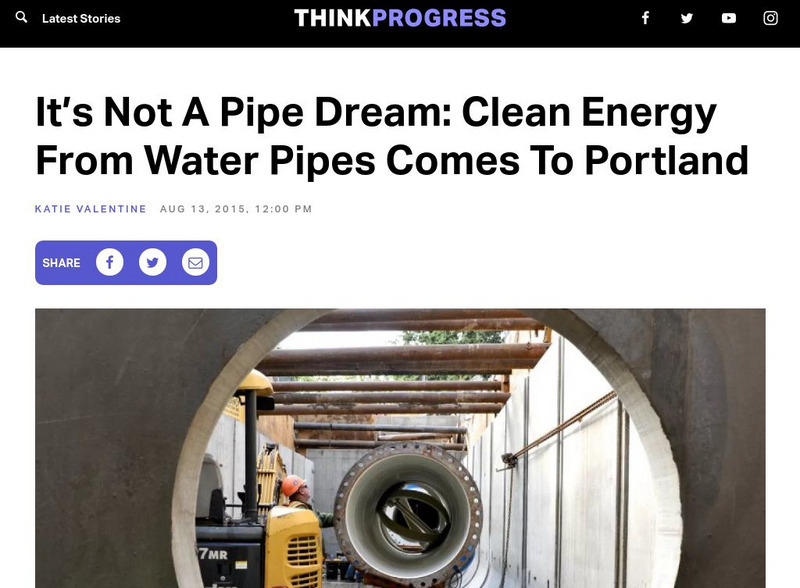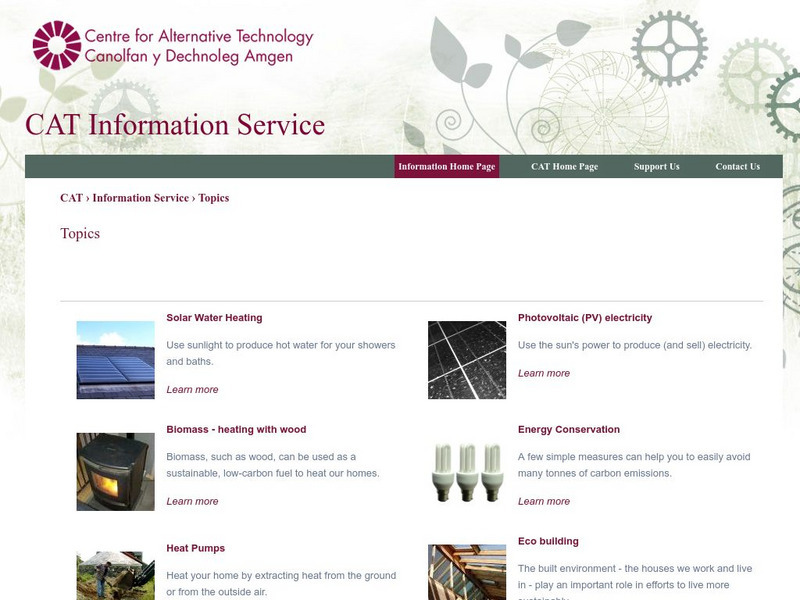TeachEngineering
Teach Engineering: Environmental Challenges in China
Students learn about the wonderful and fascinating country of China, and its environmental challenges that require engineering solutions, many in the form of increased energy efficiency, the incorporation of renewable energy, and new...
TeachEngineering
Teach Engineering: Energy Resources and Systems
Several activities are included to teach and research the differences between renewable and non-renewable resources and various energy resources. Learners work with a quantitative, but simple model of energy resources to show how rapidly...
TeachEngineering
Teach Engineering: Off the Grid
Students learn and discuss the advantages and disadvantages of renewable and non-renewable energy sources. They also learn about our nation's electric power grid and what it means for a residential home to be "off the grid."
TeachEngineering
Teach Engineering: Form vs. Function
Students take a closer look at cars and learn about some characteristics that affect their energy efficiency, including rolling resistance and the aerodynamics of shape and size. They come to see how vehicles are one example of a product...
Annenberg Foundation
Annenberg Learner: The Habitable Planet: Energy Challenges
With this resource, users join investigators in the exploration of humans' use of and dependence on the many energy resources. Learn about new technologies such as carbon capture and sequestration as an alternative to reduce our carbon...
McGraw Hill
Glencoe: Technology Education: Alternative Fuels Web Quest
The object of this WebQuest is for you to research alternative fuels and figure out their benefits. Resources are provided as well as study questions to guide your quest.
US Department of Energy
U.s. Dept. Of Energy: Geothermal Energy [Pdf]
A thorough overview of geothermal energy followed by directions for science fair projects including a glossary, standards, and a rubric.
PBS
Kqed: Quest: How Nuclear Reactors Work
This interactive explorer allows students to click on a hot spot on the image and learn more about how nuclear reactors work.
US Department of Energy
U.s. Department of Energy: Fuel Cell Technologies Program: Fuel Cell Animation
A series of animated illustrations show how a polymer electrolyte membrane fuel cell works. PEM fuel cells are the most common type used in flex-fuel vehicles.
US Department of Energy
Eere: Alternative Fuels and Advanced Vehicles Data Center Program
The Alternative Fuels and Advanced Vehicles Data Center Program offers valuable information regarding the use of alternative fuels in the United States. This center is sponsored by the U.S. Department of Energy's Clean City action....
Other
Texas Comptroller of Public Accounts: The Energy Report: Wind Energy [Pdf]
Chapter 11 of a report on the energy industry in Texas. It looks at wind energy, its history, and how it is used. The wind power industry in Texas is described, its economic importance, how it is produced and transmitted, and its...
Other
It's Not a Pipe Dream: Clean Energy From Water Pipes Comes to Portland
A Portland, Oregon-based startup that launched in 2007, is starting to capture the energy of water pipes, beginning with a pilot project in Riverside, California and now with a full-scale project in Portland.
Other
Wbur: New England's Electric Power Grid Is Undergoing a Transformation
This article discusses New England's developing hybrid power grid, a network that relies on a variety of energy resources, including fuels and alternative energy sources and technologies. The ongoing transformation to renewable energy is...
Discovery Education
Discovery Education: Science of Everyday Life: 3 M Wind Energy Virtual Lab
Do you think you can design a wind turbine that supplies energy to 400 homes at the highest efficiency and lowest cost? Try your hand at turbine design in this interactive activity that allows you design, build, and test a device to...
Other
Centre for Alternative Technology: Information Service
Information and advice on sustainable living. Provides data for people that might want to use technology in the construction or conversion of their home into an environmentally sustainable structure.
Science Buddies
Science Buddies: Build Your Own Windmill Generator
Build your own windmill and see how the wind can be converted into energy to produce electricity. This science fair project should help you understand the use of wind as a source of alternative energy. The Science Buddies project ideas...
PBS
Pbs: Pov Borders: Environment
Point of View is television's longest running showcase for independent non-fiction films. This particular feature provides insight regarding alternative means of energy, transport, and the consumption of natural resources. Video, games,...
US Department of Energy
Fus Ed Web: Physics of a Fundamental Energy Source
An excellent resource on nuclear fusion! Using incredible graphics and excellent discussion, this site (with its several pages) provides an exhaustive online course on the topic. Click on the link for "a Guided Tour" and begin.
National Geographic
National Geographic: Evaluating Other Energy Sources
A comprehensive lesson where students examine the different costs and benefits associated with renewable and nonrenewable sources of electricity. Includes a 22-question interactive module where they look at real-world data and images...
National Geographic
National Geographic: Using Waste Heat to Generate Electricity
Students learn about waste heat capture, how it can be re-used to generate electricity and develop a podcast educating others about it. Includes student handouts and links to many online resources.
PBS
Pbs Learning Media: Global Warming: Beyond Fossil Fuels
Martin Hoffert, professor of physics at New York University, discusses global warming and alternative energies in this interview from the NOVA/FRONTLINE: "What's Up with the Weather?"
State Energy Conservation Office-Texas
State Energy Conservation Office: Feasibility of Photovoltaic Systems [Pdf]
Summarizes how a photovoltaic or PV system works to convert solar energy into electricity. Explains how to estimate what size of PV system is needed and what the cost would be, and provides a worksheet with formulas for calculating...
American Museum of Natural History
American Museum of Natural History: Ology: Rising Co2! What Can We Do?
With this resource, students learn how much fossil fuel emissions have increased since 1600 by exploring a graph showing carbon dioxide in our atmosphere. Then answer questions and read facts about climate change over the centuries....
PBS
Pbs Learning Media: "Renewable Energy"
WLVT PBS 39 explores how a family in Berks County, Pennsylvania has put much of the renewable energy resources to work on their farm. All of these technologies were showcased at the Renewable Energy Sustainable Living Festival for the...



